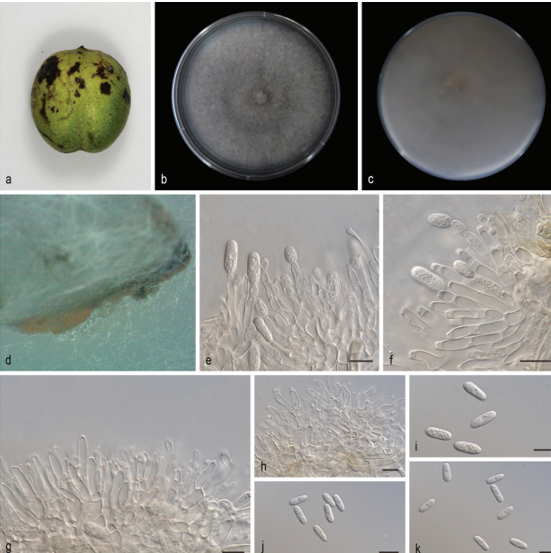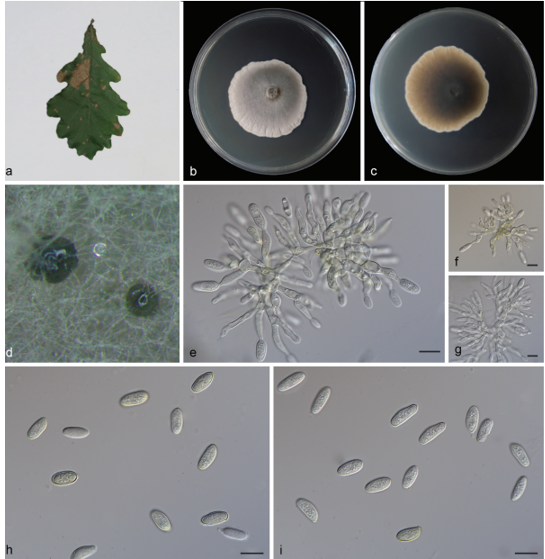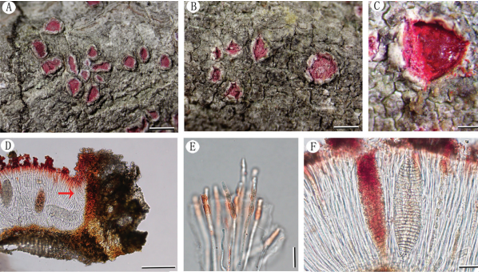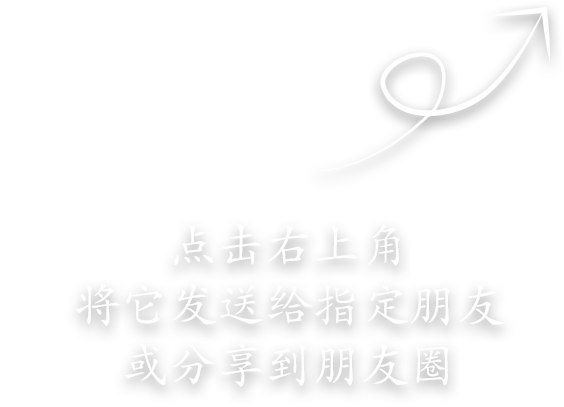Byssoloma brunneodiscum W. C. Wang & J. C. Wei 2020
Fungal Names No.: FN 570659
Holotype: China, Hainan Province, Ledong County, Jianfeng Ridge, Mingfeng Valley, 18°44′N, 108°50′E, 960 m alt., on leaves, 6 September 2017, W. C. Wang 139422 (HMAS-L—holotype).
Morphological description
Thallus epiphyllous, 0.5–1 cm diam., smooth, continuous, green, K−, P−, without hypothallus. Photobiont chlorococcoid with globose green cells, 5–7.5 μm diam.
Apothecia rounded, single, sessile, basally constricted, 0.3–0.5 mm diam., 100–120 μm high; disc plane, brown to dark brown, dull, epruinose; margin white, byssoid but compact, hyphae not forming a rim over the surrounding thallus, thick, prominent and persistent, c. 50 μm wide, K−, P−. Excipulum and apothecial base (the part below hypothecium) composed of abundant colourless loosely interwoven hyphae, encrusted with crystals which dissolve in K, K+ pink or K− (colourless or very pale green in excipulum), P−; excipulum 35–40 μm wide, apothecial base 35–40 μm high; hypothecium pale brown, poorly developed, 25–30 μm high, K−, P−; epithecium colourless or pale brown, K−, P−; hymenium hyaline, mixed with brown pigment, 40–50 μm high; paraphyses indistinct, branched and anastomosing. Asci clavate, 45–50 × 10–12 μm, 8-spored, ascus apex I+ dark blue, Byssoloma-type (Hafellner 1984); ascospores 3-septate, without gelatinous perispore, ellipsoid, colourless, 11–14 × 3–4 μm.
Pycnidia sessile, wart-shaped, 10–13 μm wide, with an apical ostiolum when mature, pale grey-brown with black centre. Conidia pyriform, colourless, non-septate, 2–2.5 × 1.5 μm.
Habitat: On leaves.
Distribution: In China.
GenBank Accession:
Notes: Byssoloma annuum is one of the most closely related species to B. brunneodiscum (both contain 2,5,7-trichloro-3O-methylnorlichexanthone), but it can be distinguished by its orange-yellow apothecia with a colourless hypothecium. A further closely related species is B. confusum Farkas & Vězda from Africa, which differs by its excipulum lacking crystals, halonate ascospores and K− apothecial base (Fárkas & Vězda 1993). Byssoloma brunneodiscum is also similar to B. polychromum (Müll. Arg.) Zahlbr. in its brown apothecia with a compact byssoid white margin and 3-septate ascospores, but the latter differs by its finely verrucose thallus and the presence of a chemosyndrome of 3-O- methylchloro-xanthones with thiophanic acid and 3-O-methylthiophanic acid, as the major components (Elix et al. 1995).
Reference: Wei-Cheng Wang1,2 ![]() , Pieter van den Boom3
, Pieter van den Boom3 ![]() , Ek Sangvichien4 et al.
, Ek Sangvichien4 et al.
Byssoloma brunneodiscum W. C. Wang & J. C. Wei 2020
Fungal Names No.: FN 570659
Holotype: China, Hainan Province, Ledong County, Jianfeng Ridge, Mingfeng Valley, 18°44′N, 108°50′E, 960 m alt., on leaves, 6 September 2017, W. C. Wang 139422 (HMAS-L—holotype).
Morphological description
Thallus epiphyllous, 0.5–1 cm diam., smooth, continuous, green, K−, P−, without hypothallus. Photobiont chlorococcoid with globose green cells, 5–7.5 μm diam.
Apothecia rounded, single, sessile, basally constricted, 0.3–0.5 mm diam., 100–120 μm high; disc plane, brown to dark brown, dull, epruinose; margin white, byssoid but compact, hyphae not forming a rim over the surrounding thallus, thick, prominent and persistent, c. 50 μm wide, K−, P−. Excipulum and apothecial base (the part below hypothecium) composed of abundant colourless loosely interwoven hyphae, encrusted with crystals which dissolve in K, K+ pink or K− (colourless or very pale green in excipulum), P−; excipulum 35–40 μm wide, apothecial base 35–40 μm high; hypothecium pale brown, poorly developed, 25–30 μm high, K−, P−; epithecium colourless or pale brown, K−, P−; hymenium hyaline, mixed with brown pigment, 40–50 μm high; paraphyses indistinct, branched and anastomosing. Asci clavate, 45–50 × 10–12 μm, 8-spored, ascus apex I+ dark blue, Byssoloma-type (Hafellner 1984); ascospores 3-septate, without gelatinous perispore, ellipsoid, colourless, 11–14 × 3–4 μm.
Pycnidia sessile, wart-shaped, 10–13 μm wide, with an apical ostiolum when mature, pale grey-brown with black centre. Conidia pyriform, colourless, non-septate, 2–2.5 × 1.5 μm.
Habitat: On leaves.
Distribution: In China.
GenBank Accession:
Notes: Byssoloma annuum is one of the most closely related species to B. brunneodiscum (both contain 2,5,7-trichloro-3O-methylnorlichexanthone), but it can be distinguished by its orange-yellow apothecia with a colourless hypothecium. A further closely related species is B. confusum Farkas & Vězda from Africa, which differs by its excipulum lacking crystals, halonate ascospores and K− apothecial base (Fárkas & Vězda 1993). Byssoloma brunneodiscum is also similar to B. polychromum (Müll. Arg.) Zahlbr. in its brown apothecia with a compact byssoid white margin and 3-septate ascospores, but the latter differs by its finely verrucose thallus and the presence of a chemosyndrome of 3-O- methylchloro-xanthones with thiophanic acid and 3-O-methylthiophanic acid, as the major components (Elix et al. 1995).
Reference: Wei-Cheng Wang1,2 , Pieter van den Boom3 ![]() , Ek Sangvichien4 et al.
, Ek Sangvichien4 et al.
Byssoloma brunneodiscum W. C. Wang & J. C. Wei 2020
Fungal Names No.: FN 570659
Holotype: China, Hainan Province, Ledong County, Jianfeng Ridge, Mingfeng Valley, 18°44′N, 108°50′E, 960 m alt., on leaves, 6 September 2017, W. C. Wang 139422 (HMAS-L—holotype).
Morphological description
Thallus epiphyllous, 0.5–1 cm diam., smooth, continuous, green, K−, P−, without hypothallus. Photobiont chlorococcoid with globose green cells, 5–7.5 μm diam.
Apothecia rounded, single, sessile, basally constricted, 0.3–0.5 mm diam., 100–120 μm high; disc plane, brown to dark brown, dull, epruinose; margin white, byssoid but compact, hyphae not forming a rim over the surrounding thallus, thick, prominent and persistent, c. 50 μm wide, K−, P−. Excipulum and apothecial base (the part below hypothecium) composed of abundant colourless loosely interwoven hyphae, encrusted with crystals which dissolve in K, K+ pink or K− (colourless or very pale green in excipulum), P−; excipulum 35–40 μm wide, apothecial base 35–40 μm high; hypothecium pale brown, poorly developed, 25–30 μm high, K−, P−; epithecium colourless or pale brown, K−, P−; hymenium hyaline, mixed with brown pigment, 40–50 μm high; paraphyses indistinct, branched and anastomosing. Asci clavate, 45–50 × 10–12 μm, 8-spored, ascus apex I+ dark blue, Byssoloma-type (Hafellner 1984); ascospores 3-septate, without gelatinous perispore, ellipsoid, colourless, 11–14 × 3–4 μm.
Pycnidia sessile, wart-shaped, 10–13 μm wide, with an apical ostiolum when mature, pale grey-brown with black centre. Conidia pyriform, colourless, non-septate, 2–2.5 × 1.5 μm.
Habitat: On leaves.
Distribution: In China.
GenBank Accession:
Notes: Byssoloma annuum is one of the most closely related species to B. brunneodiscum (both contain 2,5,7-trichloro-3O-methylnorlichexanthone), but it can be distinguished by its orange-yellow apothecia with a colourless hypothecium. A further closely related species is B. confusum Farkas & Vězda from Africa, which differs by its excipulum lacking crystals, halonate ascospores and K− apothecial base (Fárkas & Vězda 1993). Byssoloma brunneodiscum is also similar to B. polychromum (Müll. Arg.) Zahlbr. in its brown apothecia with a compact byssoid white margin and 3-septate ascospores, but the latter differs by its finely verrucose thallus and the presence of a chemosyndrome of 3-O- methylchloro-xanthones with thiophanic acid and 3-O-methylthiophanic acid, as the major components (Elix et al. 1995).
Reference: Wei-Cheng Wang1,2 ![]() , Pieter van den Boom3 , Ek Sangvichien4 et al.
, Pieter van den Boom3 , Ek Sangvichien4 et al.

A & B, Byssoloma brunneodiscum (holotype, Wang 139422). C & D, B. rubrofuscum (holotype, Wang 144214). E & F, B. melanodiscocarpum (holotype, Wang 139744). A, C & E, thallus with apothecia. B, D & F, section through apothecium (in water). Scales: A, C & E = 200 μm; B, D & F = 50 μm.
A & B, Byssoloma brunneodiscum (holotype, Wang 139422). C & D, B. rubrofuscum (holotype, Wang 144214). E & F, B. melanodiscocarpum (holotype, Wang 139744). A, C & E, thallus with apothecia. B, D & F, section through apothecium (in water). Scales: A, C & E = 200 μm; B, D & F = 50 μm.
A & B, Byssoloma brunneodiscum (holotype, Wang 139422). C & D, B. rubrofuscum (holotype, Wang 144214). E & F, B. melanodiscocarpum (holotype, Wang 139744). A, C & E, thallus with apothecia. B, D & F, section through apothecium (in water). Scales: A, C & E = 200 μm; B, D & F = 50 μm.









